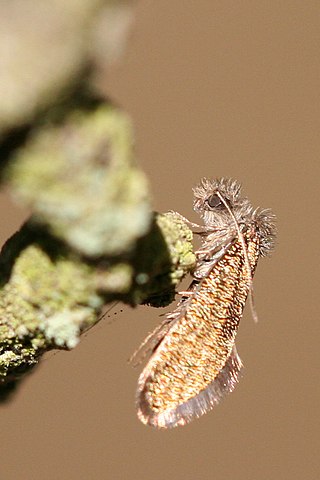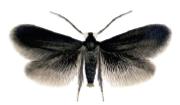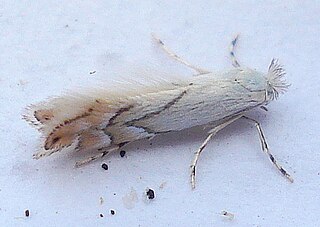
Urodidae, whose species are commonly known as false burnet moths, is a family of moths in the lepidopteran order. It is the type genus in the superfamily, Urodoidea, with three genera, one of which, Wockia, occurs in Europe.

Dyseriocrania subpurpurella is a diurnal moth from the family Eriocraniidae, found in most of Europe. The moth was first named by the English entomologist, Adrian Hardy Haworth in 1828.

Anacampsis is a worldwide genus of moth with most found in the nearctic and neotropical regions. It is in the family Gelechiidae. The larvae feed on a range of deciduous trees and shrubs in a rolled or folded leaf, or spun shoot.

Megacraspedus is a genus of moths in the family Gelechiidae, found primarily in the Palearctic.

Coleophora lutipennella is a moth of the family Coleophoridae. It is found in most of Europe, except the Mediterranean islands.

Stigmella atricapitella is a moth of the family Nepticulidae. It is found from Scandinavia to Ireland, the Iberian Peninsula, Sicily, Greece and Ukraine. It is also present in the Near East. It also occurs on Madeira, where it is most likely an introduced species.

Ectoedemia subbimaculella is a moth of the family Nepticulidae. It is found in most of Europe, east to Smolensk, Kaluganorth and the Volga and Ural regions of Russia.

Phyllonorycter roboris is a moth of the family Gracillariidae. It is found in all of Europe.

Phyllonorycter harrisella is a moth of the family Gracillariidae. It is found in all of Europe, except the Balkan Peninsula and the Mediterranean islands.

Phyllonorycter lautella is a moth of the family Gracillariidae. It is known from all of Europe, except the Mediterranean islands.

The European oak leaf-miner or Zeller's midget is a moth of the family Gracillariidae. It is found in Europe south of the line running from Ireland, through Great Britain, Denmark to Ukraine. It is also found in Macaronesia. It is an introduced species in New Zealand and Australia.
Caloptilia leucapennella is a moth of the family Gracillariidae. It is known from all of Europe, except the Balkan Peninsula.

Bucculatrix ulmella is a moth of the family Bucculatricidae. It is found in most of Europe, except the Iberian Peninsula, Slovenia and Bulgaria. It was first described in 1848 by Philipp Christoph Zeller.

Heliozela sericiella is a moth of the Heliozelidae family found in Europe. The larvae mine the twigs of oaks, causing a gall.
Dichomeris atomogypsa is a moth of the family Gelechiidae. It was described by Edward Meyrick in 1932. It is known from Korea and the Japanese islands of Honshu and Shikoku.
Dichomeris quercicola is a moth in the family Gelechiidae. It was described by Edward Meyrick in 1921. It is found in northern India, Mongolia, Transbaikalia, south-eastern Siberia, China, Korea and Japan.
Dichomeris oceanis is a moth in the family Gelechiidae. It was described by Edward Meyrick in 1920. It is found in south-eastern Siberia, Japan, China, Korea and Taiwan.
Dichomeris leptosaris is a moth in the family Gelechiidae. It was described by Edward Meyrick in 1932. It is found on the Japanese islands of Hokkaido and Honshu.
Anarsia bipinnata is a moth in the family Gelechiidae. It was described by Edward Meyrick in 1932. It is found in the Russian Far East, Korea and Japan.

Pammene splendidulana is a moth belonging to the family Tortricidae. The species was first described by Achille Guenée in 1845.










